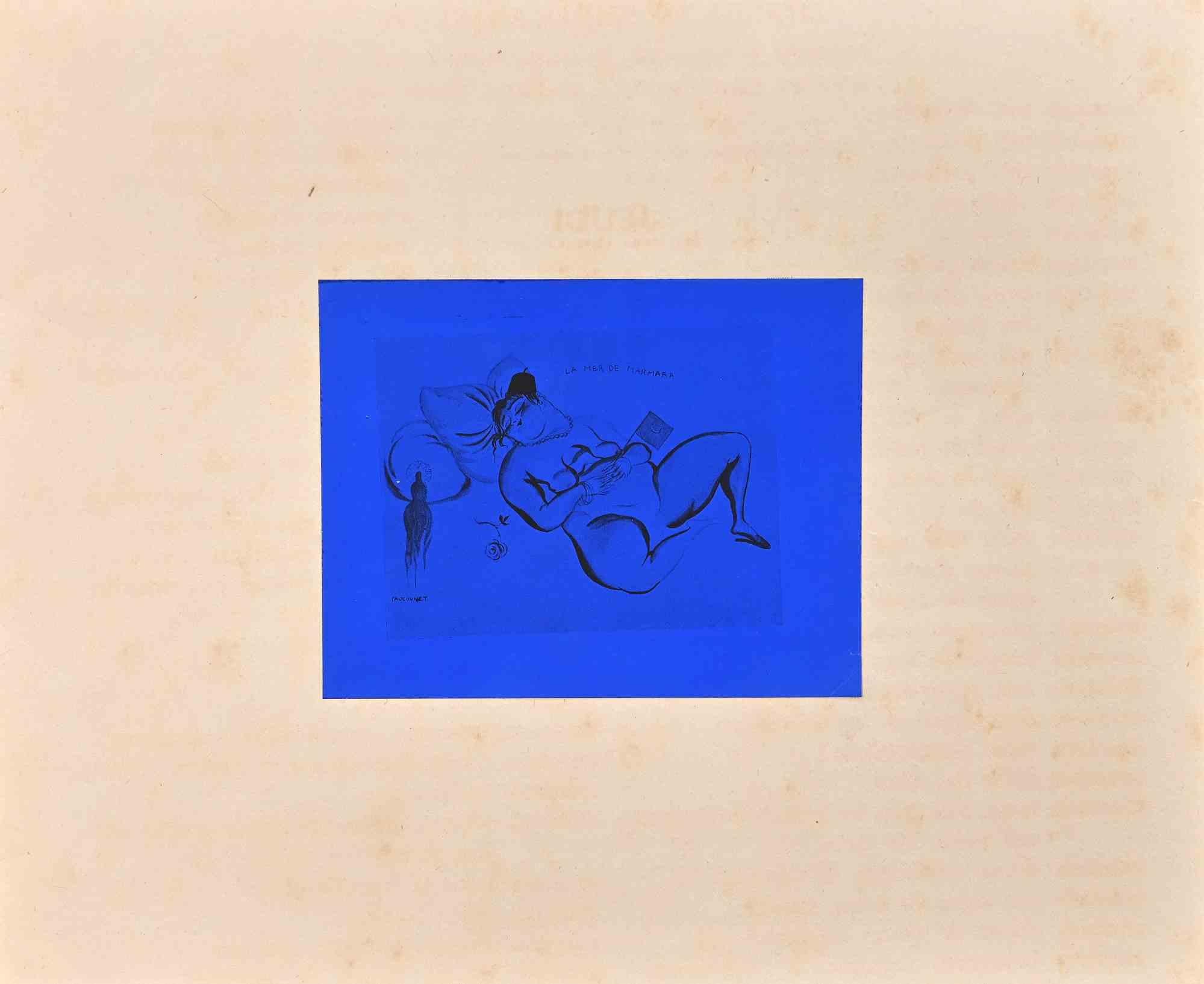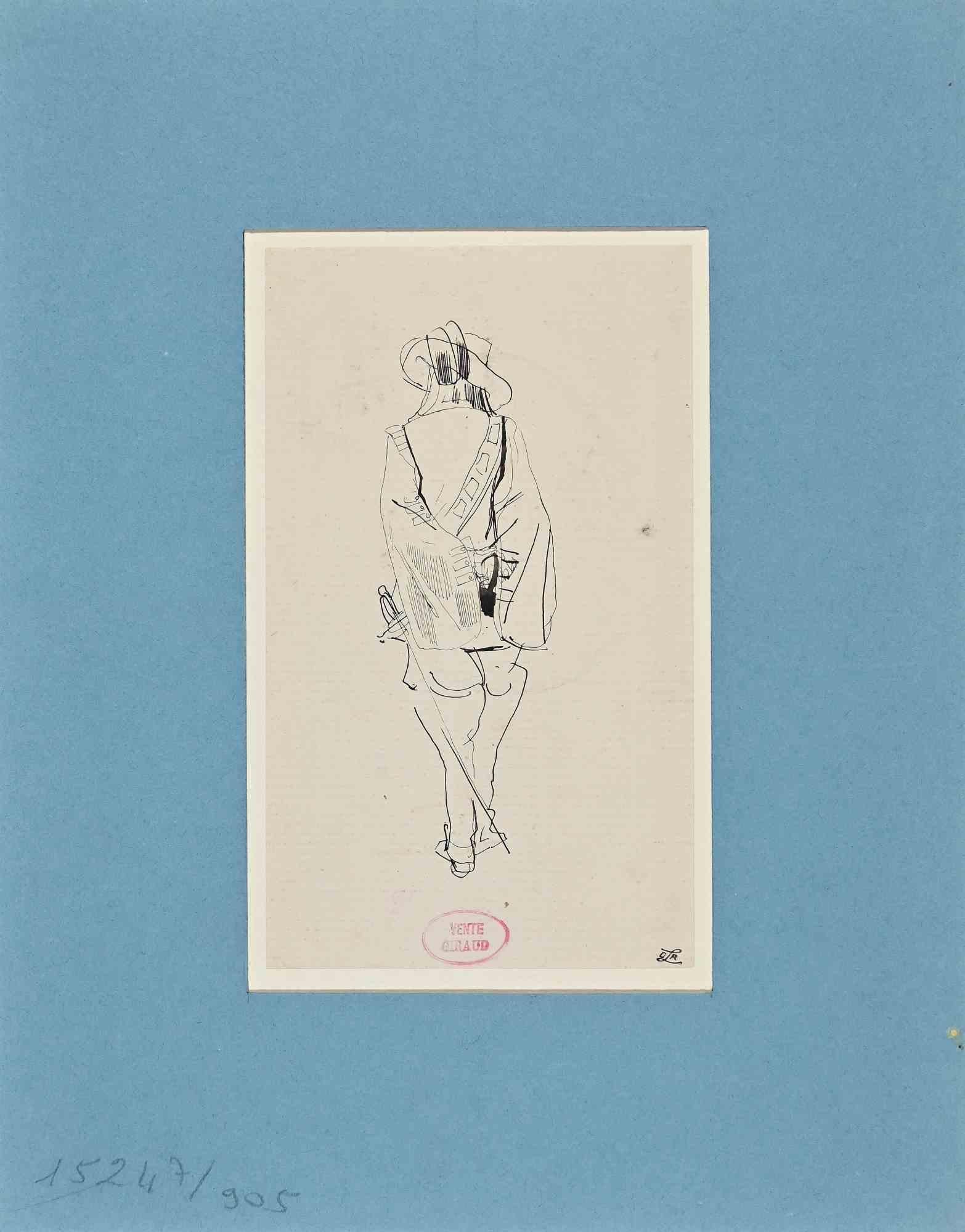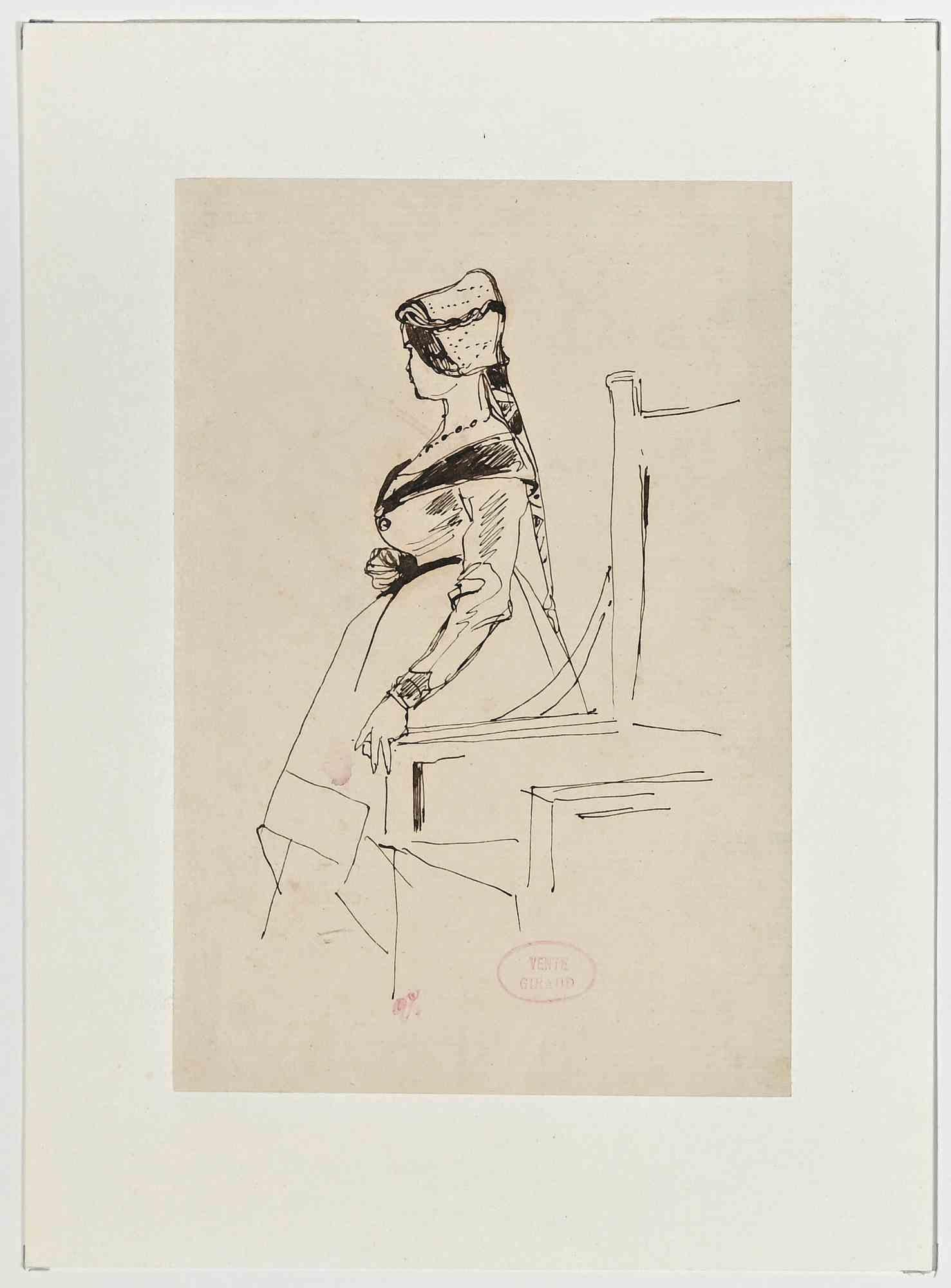Items Similar to Biblical Scene, (2 Jewish Men) 1930s Modernist Ink Drawing
Want more images or videos?
Request additional images or videos from the seller
1 of 6
Ben-Zion WeinmanBiblical Scene, (2 Jewish Men) 1930s Modernist Ink Drawing
About the Item
Born in 1897, Ben-Zion Weinman celebrated his European Jewish heritage in his visual works as a sculptor, painter, and printmaker. Influenced by Spinoza, Knut Hamsun, and Wladyslaw Reymont, as well as Hebrew literature, Ben-Zion wrote poetry and essays that, like his visual work, attempt to reveal the deep “connection between man and the divine, and between man and earth.”
An emigrant from the Ukraine, he came to the US in 1920. He wrote fairy tales and poems in Hebrew under the name Benzion Weinman, but when he began painting he dropped his last name and hyphenated his first, saying an artist needed only one name.
Ben-Zion was a founding member of “The Ten: An Independent Group” The Ten” a 1930’s avant-garde group, Painted on anything handy. Ben-Zion often used cabinet doors (panels) in his work. Other members of group included Ilya Bolotowsky, Lee Gatch, Adolf Gottlieb, Louis Harris, Yanhkel Kufeld, Marcus Rothkowitz (later known as Mark Rothko), Louis Schanker, and Joseph Solman. The Art of “The Ten” was generally described as expressionist, as this style offered the best link between modernism and social art. Their exhibition at the Mercury Gallery in New York held at the same time as the Whitney Annual Exhibition of Contemporary American Painting, included a manifesto concentrating on aesthetic questions and criticisms of the conservative definition of modern art imposed by the Whitney. Ben-Zion’s work was quickly noticed. The New York Sun said he painted “furiously” and called him “the farthest along of the lot.” And the triptych, “The Glory of War,” was described by Art News as “resounding.”
By 1939, The Ten disbanded because most of the members found individual galleries to represent their work. Ben-Zion had his first one-man show at the Artist’s Gallery in Greenwich Village and J.B. Neumann, the highly esteemed European art dealer who introduced Paul Klee, (among others) to America, purchased several of Ben-Zion’s drawings. Curt Valentin, another well-known dealer, exhibited groups of his drawings and undertook the printing of four portfolios of etchings, each composed of Ben-Zion’s biblical themes.
Ben-Zion’s work is represented in many museums throughout the country including the Metropolitan, the Whitney, and the Museum of Modern Art in New York, the Art Institute of Chicago, the Philadelphia Museum of Art and the Phillips Collection, Washington. The Jewish Museum in New York opened in 1948 with a Ben-Zion exhibition.
“Ben-Zion has his hands on the pulse of the common man and his natural world”
As he emerged as an artist Ben-Zion never lost his gift for presenting the ordinary in ways that are vital, fresh and filled with emotions that are somber and exhilarating, joyous and thoughtful, and ultimately, filled with extraordinary poetic simplicity.
Ben-Zion consistently threaded certain subject matter—nature, still life, the human figure, the Hebrew Bible, and the Jewish people—into his work throughout his life. "In all his work a profound human feeling remains. Sea and sky, even sheaves of wheat acquire a monolithic beauty and simplicity which delineates the transient as a reflection of the eternal. This sensitive inter- mingling of the physical and metaphysical is one of the most enduring features of Ben-Zion's works." (Excerpt from Stephen Kayser, “Biblical Paintings,” The Jewish Museum Catalogue, 1952).
Ben-Zion continued his style of representational painting based on the abstract, and is perhaps best known for his Biblical paintings and etchings.
Ben-Zion received an American Jewish Congress award.
In 1987, Ben Zion died in his home in the Chelsea section of Manhattan. He was 90 years old.
- Creator:Ben-Zion Weinman (1897 - 1987, American)
- Dimensions:Height: 12.5 in (31.75 cm)Width: 14.75 in (37.47 cm)
- Medium:
- Period:
- Condition:age toning to paper please see photos.
- Gallery Location:Surfside, FL
- Reference Number:1stDibs: LU38211802422
About the Seller
4.9
Platinum Seller
These expertly vetted sellers are 1stDibs' most experienced sellers and are rated highest by our customers.
Established in 1995
1stDibs seller since 2014
1,566 sales on 1stDibs
Typical response time: 1 hour
- ShippingRetrieving quote...Ships From: Surfside, FL
- Return PolicyA return for this item may be initiated within 3 days of delivery.
More From This SellerView All
- Expressionist Ink, Pastel, Crayon Drawing Jewish American Modernist Ben Zion WPABy Ben-Zion WeinmanLocated in Surfside, FLExpressionist ink and pastel crayon drawing of beans (carobs, flowers?) in pods Hand signed. Born in 1897, Ben-Zion Weinman celebrated his European Jewish heritage in his visual works as a sculptor, painter, and printmaker. Influenced by Spinoza, Knut Hamsun, and Wladyslaw Reymont, as well as Hebrew literature, Ben-Zion wrote poetry and essays that, like his visual work, attempt to reveal the deep “connection between man and the divine, and between man and earth.” An emigrant from the Ukraine, he came to the US in 1920. He wrote fairy tales and poems in Hebrew under the name Benzion Weinman, but when he began painting he dropped his last name and hyphenated his first, saying an artist needed only one name. Ben-Zion was a founding member of “The Ten: An Independent Group” The Ten” a 1930’s avant-garde group, Painted on anything handy. Ben-Zion often used cabinet doors (panels) in his work. Other members of group included Ilya Bolotowsky, Lee Gatch, Adolph Gottlieb, Louis Harris, Yankel Kufeld, Marcus Rothkowitz (later known as Mark Rothko), Louis Schanker, and Joseph Solman. The Art of “The Ten” was generally described as expressionist, as this style offered the best link between modernism and social art. Their exhibition at the Mercury Gallery in New York held at the same time as the Whitney Annual Exhibition of Contemporary American Painting, included a manifesto concentrating on aesthetic questions and criticisms of the conservative definition of modern art imposed by the Whitney. Ben-Zion’s work was quickly noticed. The New York Sun said he painted “furiously” and called him “the farthest along of the lot.” And the triptych, “The Glory of War,” was described by Art News as “resounding.” By 1939, The Ten disbanded because most of the members found individual galleries to represent their work. Ben-Zion had his first one-man show at the Artist’s Gallery in Greenwich Village and J.B. Neumann, the highly esteemed European art dealer who introduced Paul Klee, (among others) to America, purchased several of Ben-Zion’s drawings. Curt Valentin, another well-known dealer, exhibited groups of his drawings and undertook the printing of four portfolios of etchings, each composed of Ben-Zion’s biblical themes. He worked as a WPA artist. Ben-Zion’s work is represented in many museums throughout the country including the Metropolitan, the Whitney, and the Museum of Modern Art in New York, the Art Institute of Chicago, the Philadelphia Museum of Art and the Phillips Collection, Washington. The Jewish Museum in New York opened in 1948 with a Ben-Zion exhibition. Ben-Zion consistently threaded certain subject matter—nature, still life, the human figure, the Hebrew Bible, and the Jewish people—into his work throughout his life. "In all his work a profound human feeling remains. Sea and sky, even sheaves of wheat acquire a monolithic beauty and simplicity which delineates the transient as a reflection of the eternal. This sensitive inter- mingling of the physical and metaphysical is one of the most enduring features of Ben-Zion's works." (Excerpt from Stephen Kayser, “Biblical Paintings,” The Jewish Museum Catalogue, 1952). Mystical Imprints: Marc Chagall, Ben-Zion, and Ben Shahn presents the print work of three prominent 20th century Jewish artists born in the Russian Empire. Among these seventy pieces are etchings and lithographs from Chagall’s Bible series...Category
Mid-20th Century Expressionist Still-life Drawings and Watercolors
MaterialsPaper, Oil Crayon, Pastel, Ink
- Expressionist Color Drawing Cobalt Glass Vintage Frame Modernist Ben Zion WPABy Ben-Zion WeinmanLocated in Surfside, FLExpressionist ink and pastel crayon drawing of flowers in vase. Framed in a vintage cobalt blue glass original frame Hand signed and dated Framed it measures 13.5 X 10.5 The actual paper is 7.5 X 5.5 Born in 1897, Ben-Zion Weinman celebrated his European Jewish heritage in his visual works as a sculptor, painter, and printmaker. Influenced by Spinoza, Knut Hamsun, and Wladyslaw Reymont, as well as Hebrew literature, Ben-Zion wrote poetry and essays that, like his visual work, attempt to reveal the deep “connection between man and the divine, and between man and earth.” An emigrant from the Ukraine, he came to the US in 1920. He wrote fairy tales and poems in Hebrew under the name Benzion Weinman, but when he began painting he dropped his last name and hyphenated his first, saying an artist needed only one name. Ben-Zion was a founding member of “The Ten: An Independent Group” The Ten” a 1930’s avant-garde group, Painted on anything handy. Ben-Zion often used cabinet doors (panels) in his work. Other members of group included Ilya Bolotowsky, Lee Gatch, Adolph Gottlieb, Louis Harris, Yankel Kufeld, Marcus Rothkowitz (later known as Mark Rothko), Louis Schanker, and Joseph Solman. The Art of “The Ten” was generally described as expressionist, as this style offered the best link between modernism and social art. Their exhibition at the Mercury Gallery in New York held at the same time as the Whitney Annual Exhibition of Contemporary American Painting, included a manifesto concentrating on aesthetic questions and criticisms of the conservative definition of modern art imposed by the Whitney. Ben-Zion’s work was quickly noticed. The New York Sun said he painted “furiously” and called him “the farthest along of the lot.” And the triptych, “The Glory of War,” was described by Art News as “resounding.” By 1939, The Ten disbanded because most of the members found individual galleries to represent their work. Ben-Zion had his first one-man show at the Artist’s Gallery in Greenwich Village and J.B. Neumann, the highly esteemed European art dealer who introduced Paul Klee, (among others) to America, purchased several of Ben-Zion’s drawings. Curt Valentin, another well-known dealer, exhibited groups of his drawings and undertook the printing of four portfolios of etchings, each composed of Ben-Zion’s biblical themes. He worked as a WPA artist. Ben-Zion’s work is represented in many museums throughout the country including the Metropolitan, the Whitney, and the Museum of Modern Art in New York, the Art Institute of Chicago, the Philadelphia Museum of Art and the Phillips Collection, Washington. The Jewish Museum in New York opened in 1948 with a Ben-Zion exhibition. Ben-Zion consistently threaded certain subject matter—nature, still life, the human figure, the Hebrew Bible, and the Jewish people—into his work throughout his life. "In all his work a profound human feeling remains. Sea and sky, even sheaves of wheat acquire a monolithic beauty and simplicity which delineates the transient as a reflection of the eternal. This sensitive inter- mingling of the physical and metaphysical is one of the most enduring features of Ben-Zion's works." (Excerpt from Stephen Kayser, “Biblical Paintings,” The Jewish Museum Catalogue, 1952). Mystical Imprints: Marc Chagall, Ben-Zion, and Ben Shahn presents the print work of three prominent 20th century Jewish artists born in the Russian Empire. Among these seventy pieces are etchings and lithographs from Chagall’s Bible series...Category
1950s Expressionist Still-life Drawings and Watercolors
MaterialsPaper, Oil Crayon, Pastel, Ink
- Under the Archways, Streets of JerusalemLocated in Surfside, FLJudaica watercolor depicting the streets of Jerusalem, Israel, Palestine.Category
20th Century Figurative Drawings and Watercolors
MaterialsPaper, Ink, Watercolor
- Rare Judaica Drawing Sephardic Rabbi Gentleman, PalestineBy Arieh MerzerLocated in Surfside, FLDimensions w/Frame: 17 1/2" x 11 1/2" Arieh Merzer was a prominent Israeli artist and metal worker. Arie Merzer, an artist who worked in hand-hammered copper, was born in Warsaw, P...Category
Early 20th Century Figurative Drawings and Watercolors
MaterialsPaper, Ink
- Modernist Drawing, Portrait of a ManBy Abraham WalkowitzLocated in Surfside, FLAbraham Walkowitz (March 28, 1878 - January 27, 1965) was an American painter grouped in with early American Modernists working in the Modernist style. Walkowitz was born in Tyumen, Siberia to Jewish parents. He emigrated with his mother to the United States in his early childhood. He studied at the National Academy of Design in New York City and the Académie Julian in Paris under Jean-Paul Laurens. Walkowitz and his contemporaries later gravitated around photographer Alfred Stieglitz's 291 Gallery, originally titled the Little Galleries...Category
Early 20th Century Modern Figurative Drawings and Watercolors
MaterialsPaper, Ink
- Figures in the Forest, Rare Drawing, Israeli Modernist masterBy Itzhak DanzigerLocated in Surfside, FLYitzhak Danziger Genre: Expressionist Subject: People Medium: Ink Surface: Paper Dimensions w/Frame: 17" x 17" Yitzhak Danziger (Hebrew: יצחק דנציגר; 26 June 1916 – 11 July 1977) was an Israeli sculptor. He was one of the pioneer sculptors of the Canaanite Movement, and later joined the "Ofakim Hadashim" (New Horizons) group. orn in Berlin in 1916, Izhak Danziger moved to Palestine in 1923. From 1934-1937 Danziger studied at the Slade School of Fine Art, London. During the 1940s he worked in Paris with Zadkine and Brancusi. In the 1950s he exhibited in London at the Institute of Contemporary Art. He is considered to be one of Israel's most important sculptors. His work, which consists largely of environmental pieces, has been exhibited at the Hisrshhorn Museum and Sculpture Garden in Washington D.C. In 1969 Danziger was awarded the Sandberg Prize by the Israel museum. He died in 1977. When discussing Chariot II, Mordechai Omer compares it to a work of similar subject by Alberto Giacometti. He explains that Danziger, unlike Giacometti, removes the figure, leaving only the chariot itself. Omer eloquently explains that "The vehicle designed to serve the needs of the person inside is devoid of this human presence, with only the memories of its headlong downhill journeys leaving their mark in the parts of a half-ruined, half-standing chariot, allowing wide scope for the viewer's imagination. If Giacometti's chariots reminded him of hospital pharmacy wagons, Danziger's gleaming brass chariots...Category
Mid-20th Century Modern Figurative Drawings and Watercolors
MaterialsPaper, Ink
You May Also Like
- Gustav Melcher ( German, 1898 -?) Boats off Venice Italy Ink Water Color c. 1918By Gustav MelcherLocated in Meinisberg, CHGustav Melcher (German, 1898-?) Segelschiffe vor Venedig - Sailing ships off Venice • India ink, water colour wash • Visible image ca. 11.5 x 18 cm • Glased Frame ca. 20 x 25 cm • Verso various inscriptions • Signed lower right Worldwide shipping for this object is complimentary - There are no additional charges for handling & delivery. Gustav Melcher was a German painter and a pioneer in film, film criticism and film theory and created this clever little picture of the skyline of Venice with various vessels. Going by the various inscriptions an the backing paper, this drawing was made in 1918 when Gustav was twenty years old and passed on three years later to Gertrud Melcher on the 1. 2. 1921. I have no reasons to doubt this information. The small drawing is still in its unopened frame, so maybe there is more information to be discovered , however this will be the privilege of the next owner. The picture also has retained its original antique frame – note that it has lost over the years various sections of the gesso decoration. The very precisely executed drawing is most enjoyable to look at and doing so, remember you are looking through the eyes of a young man, who saw this foreign sea cape over a century ago. Thank you for your interest and please note, that I offer free worldwide shipping on all my items. Gustav Melcher began his studies at the Düsseldorfer Kunstakademie under Peter Janssen and Eduard von Gebhardt. Originaly he was interested in figurative and portrait painting, but after time he decided to pursue the depiction of land- and marinescapes. Durin his studies the young artist undertook trips to visit England, Scotland, Belgium and France and he joined the artist society Malkasten. It was in those days he would hold speeches to his colleges about this new invention called ‘Kintopp’ – Melcher was a great advocate of the moving pictures...Category
1910s Naturalistic Landscape Drawings and Watercolors
MaterialsIndia Ink, Paper, Watercolor
- Sea of Marmara - Drawing by Guy Pierre Fauconnet - Early-20th centuryLocated in Roma, ITThe Sea of Marmara is an Original China Ink Drawing on a blue paper realized by Guy Pierre Fauconnet (1882-1920). The very beautifull little artwork in in good condition on a blue electric paper, included a cream colored cardboard (20x24 cm). Hand-signed and titled by the artist. Guy Pierre Fauconnet born in Chelles in 1882, he moved to the Palais du Luxembourg where his father was head of the Senate...Category
1950s Modern Figurative Drawings and Watercolors
MaterialsInk, Paper
- Musketeer from Behind- Drawing on Paper by E. Giraud - Late 19th CenturyBy Eugène GiraudLocated in Roma, ITMusketeer from Behind is an Original Drawing in China Ink and watercolor realized by Eugène Giraud in the Late 19th Century. Good conditions. The delicate and beautiful fine stroke...Category
Late 19th Century Modern Figurative Drawings and Watercolors
MaterialsInk, Paper
- Profile of Woman - Original Drawing on Paper by E. Giraud - Late 19th CenturyBy Eugène GiraudLocated in Roma, ITProfile of Woman from behind is an Original Drawing in China Ink realized by Eugène Giraud in the Late 19th Century. Good conditions. The delicate a...Category
Late 19th Century Modern Figurative Drawings and Watercolors
MaterialsPaper, Ink
- "The People People 4, " Acrylic Paint and Watercolor on Paper, 2006Located in Chicago, ILIn this series entitled "The People People," Tracy Crump uses washes of grey, white and aqua to both conceal and reveal sensitively drawn figures. Each figure stands alone as an indi...Category
21st Century and Contemporary Outsider Art Figurative Drawings and Water...
MaterialsPaper, Ink, Acrylic, Watercolor
- LepidopteraBy Shamona StokesLocated in Jersey City, NJWatercolor, flashe, color pencil, ink, silver paint, matte medium and Black 3.0 on watercolor paper, 55" high x 77" wide Vivid matte blue, red, gray, silver and black Framing availa...Category
2010s Contemporary Figurative Drawings and Watercolors
MaterialsPaper, Ink, Archival Ink, Watercolor, Archival Paper, Color Pencil





